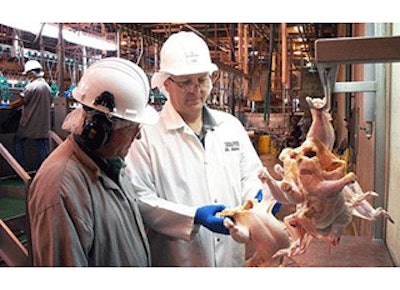
It’s not a matter of why the chicken crossed the road anymore, but instead how quick.
In a move that is said to result in 5,000 fewer foodborne illnesses each year, the Obama Administration is overhauling poultry plant inspections for the first time in half a century.
So, why are the United States Department of Agriculture’s new requirements for inspection so controversial?
The final rules would reduce the number of chicken inspectors, but those who remain will be focusing their attention more on food safety rather than quality.
In an industry where there seems to be recalls left and right, you would think the tighter restrictions would be beneficial for poultry plants. But instead, it’s got them fussing like an old hen. (Pun intended)
Here’s why: In order to put all attention on safety, chicken facilities are required to pull birds off the production line for closer inspections. The new rules cap the maximum line speed at 140 birds per minute, rather than the 175 the industry wanted.
While some groups think this is a big step forward, many others definitely do not.
To break it down, the USDA’s new rules will:
- Prevent 5,000 illnesses a year from Salmonella and Campylobacter
- Put trained USDA inspectors on production lines
- Require poultry operations to test for Salmonella and Campylobacter at two separate points of the production process.
- Give poultry producers the option of doing their own inspections.
- Maximizes line speed at 140 birds per minute.
- Estimates the public health benefit at $79 million.
When the proposed rule has been issued, the notice will be available on the Food Safety and Inspection Service website.
So, why does all this matter?
First, line speed.
The speed of poultry production lines has been a major factor in the high rate of injuries among workers, with more than one-third of whom are Latino.
Janet Murguía, president and CEO of the National Council of La Raza, the largest national Hispanic civil rights and advocacy organization in the U.S., said:
“Responding to a key concern raised by the courageous poultry workers who exposed the human cost of bringing chicken to our dinner plates, Secretary of Agriculture Tom Vilsack and Secretary of Labor Tom Perez took an important step to prioritize safety.”
The National Council of La Raza wrote to the USDA in 2012, requesting line speeds be lowered due to unsafe working conditions that threatened poultry workers.
While consumer groups have said an overhaul is necessary to bring the inspection system into the 21st century, the poultry industry is not pleased.
The National Chicken Council argues that:
“…Politics have trumped sound silence, 15 years of food and worker safety data and a successful pilot program with plants operating at 175 birds per minute. The rule also goes against global precedent, in which the limiting factors for line speeds are the ability to meet food safety standards, keeping workers safe and the capability of the equipment to run effectively — not government regulations. Broiler plants in Brazil and Argentina…among others, all operate at line speeds of 200 or more birds per minute.”
Secondly, the new rule shifts the responsibility of inspection to company employees. This could potentially pose a conflict of interest for managers to be able to keep the lines moving quickly, while needing to carefully inspect the chickens.
I say let’s give it a try. After all, wouldn’t you rather put food safety at the forefront and prevent the possibility of contamination leading to a recall? While the new regulations are a step forward, it’s difficult to believe that poultry line inspection is really any better at 140 birds per minute, which — in case you were wondering — breaks down to 2.3 birds per second.
What are your thoughts on the new inspection regulations? Are you for or against it? I’d love to read your thoughts. Please comment below.



















